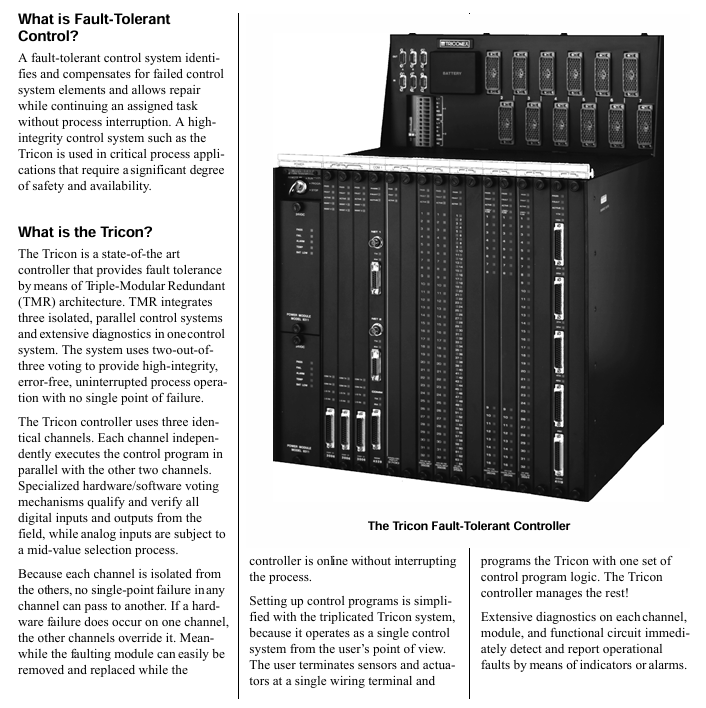TRLC0NEX Tricon fault-tolerant controller
TRLC0NEX Tricon fault-tolerant controller
Product core positioning and fault tolerance principle
1. Core Definition
Tricon is a fault-tolerant controller designed for safety critical industrial scenarios. It uses a triple modular redundancy (TMR) architecture to achieve fault detection, compensation, and online maintenance, ensuring uninterrupted process control. It is suitable for industrial environments with extremely high requirements for safety and availability.
2. Fault tolerant core mechanism
Architecture design: The system is fully triple from input module, main processor to output module, with three independent channels (A/B/C) running in parallel and communicating synchronously through a proprietary TriBus bus.
Data processing rules: The "two out of three" voting mechanism is used for digital input/output, and the median selection method is used for analog input to ensure that erroneous data is blocked.
Fault handling: When a single channel fails, the other channels automatically take over control, and the faulty module can be plugged and replaced online without stopping the machine.
Diagnostic capability: Each channel, module, and functional circuit is equipped with comprehensive diagnostic functions, which provide real-time feedback on faults through indicator lights or alarm signals. Diagnostic data can be called by control programs or operators.
3. Core advantages
No single point of failure design, supports 3/2/1 main processor (MP) operation mode, ensuring that operation can still be maintained in extreme situations.
Remote I/O supports transmission up to 7.5 miles (12 kilometers), suitable for large-scale industrial scene layouts.
The full range of I/O modules covers digital, analog, pulse, thermocouple and other signal types, supporting dual module or single module configurations, balancing safety and cost requirements.
Continuous operation and online maintenance capabilities significantly improve system availability.

System hardware composition and specifications
1. Core hardware components
(1) Main Processor Module (MP)
Model: Model 3008 (suitable for v9.6 and above systems), equipped with 16MB DRAM, 32KB spare SRAM, and 6MB Flash PROM.
Core chip: Motorola MPC860 32-bit processor, with a main frequency of 50MHz, TriBus communication rate of 25Mbps, and support for DMA synchronous transmission.
Power protection: Powered by dual power modules, the program and hold variables can maintain integrity for at least 6 months after power failure.
Indicator lights: including status indicators such as PASS (self-test pass), FAILT (fault), ACTION (running), etc.
(2) Power module
Configuration: Each chassis is equipped with 2 redundant power modules that support hot swapping, and a single module can meet the power supply needs of the entire chassis.
Input specifications: Available in 24VDC, 115VAC, and 230VAC versions, with input voltage ranges of 22-31VDC, 85-140VAC, and 185-285VAC, respectively.
Output parameters: 175 watts (at 60 ° C environment), output voltage 6.5VDC ± 1%, maximum output current 27A.
Protection function: Built in over temperature (triggered at 83 ° C), low battery, overvoltage/undervoltage diagnosis, supports alarm contact output.
(3) I/O module
Covering types such as digital input/output, analog input/output, pulse input/accumulator, thermocouple input, etc., the core specifications are as follows:
Example of key parameters for module types and typical models
TMR digital input voltage range is 24/48/115VAC/VDC, with 32/64 points, supporting self-test testing for 3501E/3503E/3504E
Single channel digital input 24VDC, 64 points, optimized cost type, triple critical path 3564
TMR digital output voltage range 24/48/120VDC, 115VAC, with 8/16/32 points, supporting voting and circuit diagnosis 3604E/3624/3611E
Analog input supports 0-5/0-10VDC, 4-20mA, thermocouple (J/K/T/E), 12/14 bit resolution, isolated/non isolated versions 3703E/3708E/3721
Analog output 4-20mA (8 points) or 4-20mA+20-320mA (high current version), accuracy ± 0.25% FSR 3505E/3806E
Pulse module frequency range 20Hz-20kHz (input), 0-1kHz (cumulative), supports speed and flow measurement 3511 (input)/3515 (cumulative)
(4) Communication module
Provide multiple types of communication interfaces, supporting interconnection with Modbus devices, DCS systems, Ethernet hosts, etc. The core models are as follows:
Module Name Communication Protocol/Interface Core Function Model
TCM (Tricon Communication Module) Ethernet (802.3), RS-232/485 supports Modbus TCP, Peer to Peer, GPS timing 4351A/4352A/4353
EICM (Enhanced Intelligent Communication Module) RS-232/422/485, parallel port Modbus master/slave communication, supports printer connection 4119/4119A
NCM (Network Communication Module) Ethernet (802.3) supports OPC Server, TSAA protocol, GPS synchronization 4329/4329G
SMM (Safety Manager Module) Honeywell UCN bus docking with TDC 3000 DCS, safety node communication 4409
ACM (Advanced Communication Module) Foxboro I/A Nodebus interfaces with Foxboro DCS and supports TriStation protocol 4609
HIM (Hiway Interface Module) Honeywell Data Hiway/LCN docking with TDC 3000/2000 DCS 4509
RXM (Remote Expansion Module) multi-mode/single-mode fiber remote I/O expansion, capable of transmitting up to 12 kilometers from 4200-3/4210-3 (main) to 4201-3/4211-3 (slave)
- EMERSON
- Honeywell
- CTI
- Rolls-Royce
- General Electric
- Woodward
- Yaskawa
- xYCOM
- Motorola
- Siemens
- Rockwell
- ABB
- B&R
- HIMA
- Construction site
- electricity
- Automobile market
- PLC
- DCS
- Motor drivers
- VSD
- Implications
- cement
- CO2
- CEM
- methane
- Artificial intelligence
- Titanic
- Solar energy
- Hydrogen fuel cell
- Hydrogen and fuel cells
- Hydrogen and oxygen fuel cells
- tyre
- Chemical fiber
- dynamo
- corpuscle
- Pulp and paper
- printing
- fossil
- FANUC
- Food and beverage
- Life science
- Sewage treatment
- Personal care
- electricity
- boats
- infrastructure
- Automobile industry
- metallurgy
- Nuclear power generation
- Geothermal power generation
- Water and wastewater
- Infrastructure construction
- Mine hazard
- steel
- papermaking
- Natural gas industry
- Infrastructure construction
- Power and energy
- Rubber and plastic
- Renewable energy
- pharmacy
- mining
- Plastic industry
- Schneider
- Kongsberg
- NI
- Wind energy
- International petroleum
- International new energy network
- gas
- WATLOW
- ProSoft
- SEW
- wind
- ADVANCED
- Reliance
- YOKOGAWA
- TRICONEX
- FOXBORO
- METSO
- MAN
- Advantest
- ADVANCED
- ALSTOM
- Control Wave
- AB
- AMAT
- STUDER
- KONGSBERG
- MOTOROLA
- DANAHER MOTION
- Bently
- Galil
- EATON
- MOLEX
- Triconex
- DEIF
- B&W
- ZYGO
- Aerotech
- DANFOSS
- KOLLMORGEN
- Beijer
- Endress+Hauser
- MOOG
- KB
- Moxa
- Rexroth
- YAMAHA
- Johnson
- Westinghouse
- WAGO


Email:wang@kongjiangauto.com




































































































































